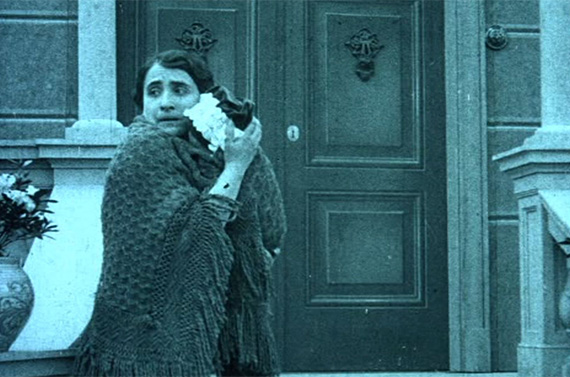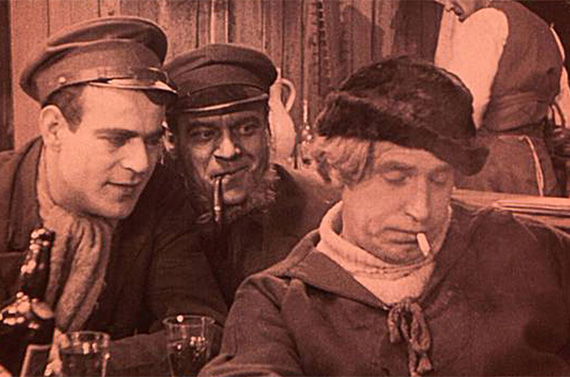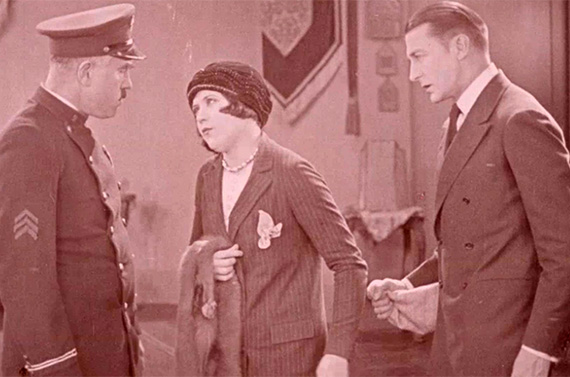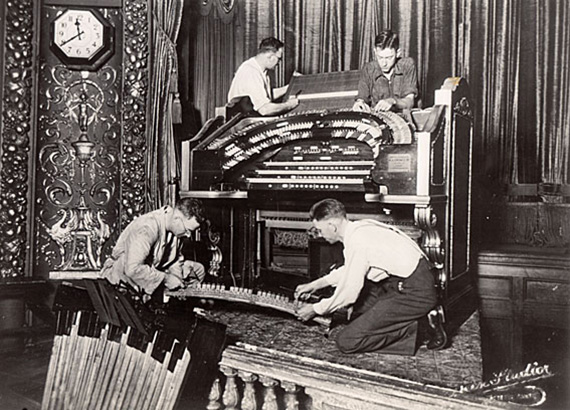The Australian Cinémathèque’s program of once-lost films begins Sunday 5 February 2017 with the launch of our free ‘Lost Cinema: Queensland Discoveries’. Join film treasure hunter Joel Archer for a lively In-Conversation, followed by screenings of two short Italian melodramas which he helped rediscover.
11.00am | In Conversation: Joel Archer
11:45 | La Prigione D’acciaio (Prisoner of the Owls) 1913 + Angelo Che Redime (The Redeeming Angel) 1913
The print of Angelo Che Redime (The Redeeming Angel) 1913 was found almost entirely complete and in remarkably good quality. The short film is almost totally intact, with only an unfortunately sudden ending (seemingly less than a minute before the true conclusion of the film) giving away its previously vulnerable state. The Redeeming Angel finds a couple in the aftermath of a fiery divorce. Due to the closure of their bank, the former wife, Ida, stops receiving her alimony and finds herself impoverished. As she is no longer able to afford to care for their infant daughter, she attempts to return their baby to her ex-husband. However, the infant’s return is interrupted by a burglary attempt on her ex-husband’s house. The film is beautifully shot, with a wide variety of locations and some wonderfully expressive performances. It is an engaging drama and a rare chance to see a rich production produced more than a century ago.
 Production still from The Redeeming Angel 1913 / Director: Attillo Fabbri
Production still from The Redeeming Angel 1913 / Director: Attillo Fabbri
Roberto Roberti’s La Prigione D’acciaio (Prisoner of the Owls) 1913 is comparatively far less complete. The short appears to be missing a small amount of footage from the first scene and there is a gap of what appears to be several scenes from the middle of the film. The broad narrative can be followed without issue but these gaps mean that it is far more interesting as a historical insight than as a twisting narrative experience.
Nevertheless, Prisoner of the Owls remains a terrifically enjoyable experience to watch. At its core is a tragedy of forbidden love, driven by class hierarchies and the inescapable stain of a criminal past. Lord Wilmer, the wealthy father of Vera, forbids the marriage of his daughter to her love. That young man’s father takes great offence at this rebuke and organises for his son’s criminal friend to be introduced to Lord Wilmer as a Duke, in an attempt to his family’s reputation by Vera’s inadvertent marriage to a member of the criminal organisation, the Owls. At this point, the missing material from the film means there are some large holes in the narrative. However, the spectacle of the (literally) fiery conclusion means it remains a rousing ride all the way to the final frames.
Due to the condition in which the prints were found, neither was able to be digitised in their entirety. However, they both provide fascinating insights into filmmaking styles at the time and have clear emotional cores which drive their drama.
Both films will feature live musical accompaniment from David Bailey on the Gallery’s 1929 Wurlitzer organ.
 Production still from The White Desert 1922 / Director: Ernst Wendt
Production still from The White Desert 1922 / Director: Ernst Wendt
On Sunday 12 February at 11.00am come along to see German seafaring adventure tale Die weiße Wüste (The White Desert) 1922 – complete with shipwrecks and bear attacks.
Drama abounds on land and the high seas in this rollicking adventure story. The White Desert follows a group of fur trappers on their trek into the icy north. The divided crew faces off against mutiny, sabotage, treachery, and the unforgiving elements as their journey becomes a fight for survival after a shipwreck.
This screening is a presentation of the restoration of Ernst Wendt’s The White Desert, pieced back together by the Filmmuseum München after a largely complete film print was discovered in Queensland. The rediscovered copy of the film is of the English-language release, which differed in significant ways from the German version originally released at the same time – notably in names, certain sequences, and in some variants of tone. Using a decomposing and incomplete German-language copy of the film, the Filmmuseum München restored the film back to its current and extraordinary digital form. German intertitles and scenes cut by the German censor were reinserted, along with some explanatory intertitles inserted for the remaining gaps.
The result of the remarkable discovery in Queensland and the diligence of the Filmmuseum München is a wonderful seafaring adventure featuring incredible footage of arctic animals, imposing icy vistas, and melodramatic tension in the sailors’ hometown.
This screening will feature live musical accompaniment from David Bailey on the Gallery’s 1929 Wurlitzer organ.
 Production still from Seven Sinners 1925 / Director: Lewis Milestone / Courtesy: Academy Film Archive
Production still from Seven Sinners 1925 / Director: Lewis Milestone / Courtesy: Academy Film Archive
Finally, on Sunday 19 February at 11.00am, the Cinémathèque plays host to the World Premiere of Lewis Milestone’s crime-caper film Seven Sinners 1925 – restored and resurrected by the Academy Film Archive.
This screening of Seven Sinners at the Australian Cinematheque, GOMA will mark the world premiere of the restoration of the long-lost debut feature film of Academy Award winning director Lewis Milestone. The film has been carefully restored by the Academy Film Archive, who have put together a presentation that lovingly weaves together the largely complete print of the film, production stills of moments from the few missing scenes, along with valuable explanatory intertitles to ensure narrative cohesion. The result is a smooth flowing restoration of an uproariously funny crime-caper presented for the first time in decades.
Seven Sinners is set within a grand Long Island mansion. Two sets of burglars have broken in to steal a collection of valuable jewels from the owners’ safe. When unexpected guests arrive to occupy the house while the owners are away, the crooks must pretend to be the new house staff while they figure out how to get away with the loot undetected. Little do they know that the ‘guests’ are themselves criminals, hoping to steal away with the big score – and they won’t be the last to join them.
Milestone (in his directorial debut, after working as Assistant Director on a series of military shorts) brings a talented comic touch to proceedings, with the film barrelling through deceit upon deceit while every character tries to get out on top. He would go on to win two Academy Awards: for his 1927 film Two Arabian Knights and then later for the classic All Quiet on the Western Front 1930. The film further flourishes on the chemistry between its two leads: Clive Brook and Marie Prevost, who bring a wonderful sense of liveliness to their roles.
The film itself is largely complete and well preserved and is seemingly missing only a few minutes from its original runtime. However, there is a roughly 12 minute section within Seven Sinners where there has been fairly significant damage to the print. The team at the Academy Film Archive have preserved this section and retained it within the film. Although there is significant on-screen emulsion (which distorts the frame), there is still plenty of information and action within these moments. It is a brief interlude that showcases the potential dangers of unpreserved film stock, while assisting in keeping the film’s cohesion together.
Seven Sinners is a wonderfully entertaining silent crime-comedy that deserves the tremendous attention-to-detail that it has been given by the Academy Film Archive in their restoration.
 Installation of the Wurlitzer console at the Regent Theatre in 1929 by the staff of Whitehouse Bros / Photography: Howell Whitehouse / Source: http://www.ohta.org.au/confs/Qld/Wurlitzer.html
Installation of the Wurlitzer console at the Regent Theatre in 1929 by the staff of Whitehouse Bros / Photography: Howell Whitehouse / Source: http://www.ohta.org.au/confs/Qld/Wurlitzer.html
The Gallery’s Wurlitzer Organ was originally installed in Brisbane’s Regent Theatre which opened on 8 November 1929, where it remained until 1964. After a period in private ownership it was returned to Queensland in 2004 and installed in the Galley of Modern Art’s Australian Cinémathèque in 2007. Hardly altered at all over the years, it remains an important part of Queensland’s cultural heritage.
The Australian Cinémathèque at GOMA
Want to know what’s on at QAGOMA?
Find out more about our exhibitions
Copyright © 2008
This feed is for personal, non-commercial use only.
The use of this feed on other websites breaches copyright. If this content is not in your news reader, it makes the page you are viewing an infringement of the copyright. (Digital Fingerprint:
)